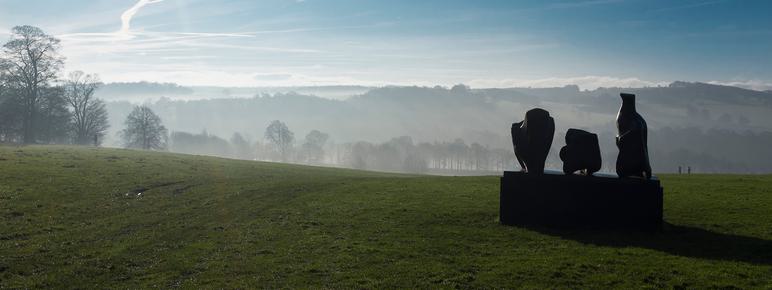
Henry Moore: Three Piece Reclining Figure No.1
Art Outdoors /Henry Moore: Three Piece Reclining Figure No.1
Three Piece Reclining Figure No.1 reveals the extent to which the bones and other natural objects that Moore collected influenced his works, with one section of this sculpture drawn directly from an animal vertebra. As the artist suggests in this quote, although the three forms are physically disconnected, there is an irresistible relationship between them. The figure is heavily abstracted as well as being fragmented, with the ‘head’, for example, being barely a suggestion.
The sculpture’s surface is heavily textured and suggestive of a rock’s surface, so the body can also be read as a landscape, something that is especially relevant in its current position. Not only is the hillside beyond as backdrop to the sculpture, but it is also seen through the voids in its three sections.
The middle piece was suggested by a vertebra – of I don’t know what animal it was – that I found in the garden. And the connection of one piece to another is the kind of connection that a backbone will have with one section through to the next section. But they’ve been separated. It’s as though you’ve left the slipped disc out of them, but it’s there.
- Henry Moore
You might also like
- Art Outdoors

Ursula von Rydingsvard: Heart in Hand
Heart in Hand relates to an earlier, larger work called Luba that was made in cedar and bronze, and is on permanent display at Storm King Art Center in upstate New York. Both works are intended to suggest a sense of protection and nurturing, like the arm of a mother cradling a baby. - News

A selection of Henry Moore works from YSP are to be included in an exhibition at Kew
25 August 2025 - Art Outdoors

Andy Goldsworthy: Shadow Stone Fold
- Art Outdoors

Henry Moore: Upright Motives No. 1 (Glenkiln Cross): No 2; No 7
Moore created twelve Upright Motives in the mid 1950s. In their powerful symbolism these pieces owe much to the tall, upright stones, known as menhirs, from prehistoric times. Moore brought all these influences together to create forms which are unmistakably his own.


